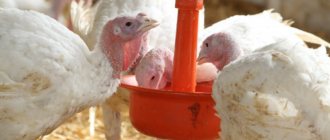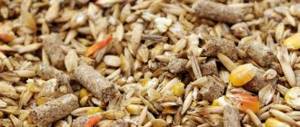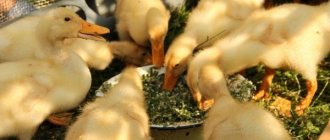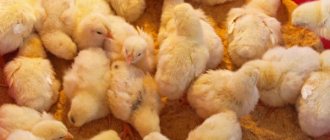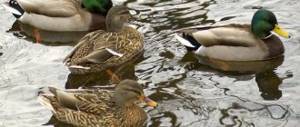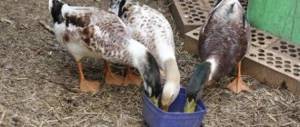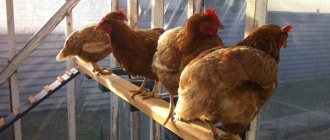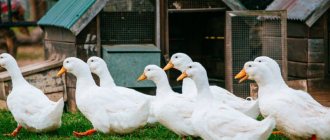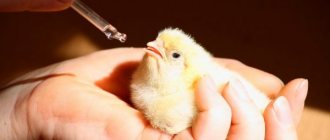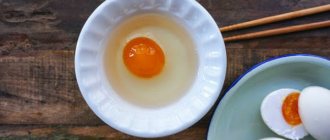Why do you need a perch for turkeys and how to make one?
Responsible farmers create excellent living conditions for their pets, thinking through to the smallest detail their habitat, food, walking environment and other important factors. In the case of birds, it is necessary to create a special poultry house with all the amenities for comfortable living, which contributes to the appearance of more product. A turkey perch is a must-have item for those looking to obtain quality meat products.
The need for a perch for turkeys
Often, the complexity of keeping this type of poultry exceeds. Any animal requires attention, but if you organize the working moments correctly, then no difficulties will arise. What are good perches for turkeys?
Perches for turkeys: DIY building tips
Some poultry farmers do not understand the need to create such places for turkeys, considering them a waste of money. What is the use of perches?
Any bird, like a person, needs a personal place of residence, the role of which is played by the hen. What should it be like? Recommendations for creating it yourself are as follows:
- It is located in the warmest part of the turkey house - in the back.
- The design of this part resembles a regular slide with many rows of different levels. Steps are necessary for conveniently lifting the bird to the height of its place.
- Each cell must have dimensions of 70 by 70 mm and with a line pitch of at least one and a half meters.
- The recommended distance between places is 60 cm. Remember, every centimeter is important here.
- For comfortable removal of straw from the perch, you can make a structure with wheels. How it should look in reality can be seen in a video from experienced farmers.
The placement of hens should be in different rows. If this condition is not met, then there is a possibility that all the birds will choose one place for their purposes.
By looking at the photos of the finished hens, you can make sure that each turkey should have its own nest, the arrangement of which should be taken seriously. It should be located 30 cm above the floor level, with a total height of 50-60 cm. To keep the eggs safe and sound, make a 20-centimeter threshold and cover the bottom with a thick layer of hay.
You can attract the bird's attention by placing one egg or its dummy in the house, because if it is hollow, the turkey may go away.
Hen: necessary materials
Creating a comfortable habitat for these birds, namely living quarters, is not at all difficult. But it’s still worth thinking about the building plan in order to avoid such problems: frequent diseases of turkeys, poor and slow growth, crowding and struggle for more spacious space, low egg production and constant stress.
First of all, it is important to decide on the materials and tools in order to create a good place to live with your own hands. Among the abundance of construction facilities, there will be a need for:
- construction level to make the walls and floor of the perch as even as possible, adhering to right angles;
- tape measure for measuring the length, width, height of a building;
- drills, the purpose of which is to quickly create neat holes in the right places;
- saw for cutting wood into specific pieces;
- a screwdriver for easily and quickly screwing in or unscrewing metal structures or elements;
- self-tapping screws;
- nails to connect the walls and floors of the hens together;
- hammer for hammering nails and other parts.
Bars of deciduous trees are suitable for perching
Farmers often ask the question: what type of wood is best for a home-made hen? Experts advise using bars made from deciduous trees. They are highly durable, practically resistant to external influences and are not characterized by such problems as the release of resin and other harmful substances. You don't have to worry about whether the floor will sag under the weight of the bird or whether the turkey will feel comfortable.
Coniferous trees are also suitable, but their quality is much worse. Accordingly, the service life of hens made of this material will be significantly shorter.
Construction and arrangement of turkey poultry
Building a room for turkeys with your own hands will not be difficult. You can build a turkey house from scratch or use a ready-made structure, which will only need to be properly equipped and furnished.
Many farmers do not pay due attention to the poultry house for turkeys, believing that any roof over their head will do for them. However, turkeys are birds that are quite demanding in terms of living conditions, and illiterate organization of the turkey poultry can lead to diseases, slow weight gain, retarded development, and decreased egg production.
Read also: Description of the Paduan chicken breed
To avoid mistakes and raise a healthy bird that will produce the expected result, read this article to the end and you will learn how to build a house for turkeys and properly arrange the inside of the turkey poultry so that the birds feel cozy and comfortable.
Perches for turkeys: drawings and construction instructions
Having decided on the materials and having found the necessary tools, you can begin drawing up and developing a drawing. Even if you want to implement your personal ideas for building a unique cage for turkeys, you need to be guided by already tested and invented schemes.
Consider the overall dimensions of the entire turkey poultry and the location of windows, doors, walls, feeders, drinkers, ash and sand trays and other details. The location of the walking area in relation to the entrance to the turkey house is also important. According to farmers, the window should open easily and provide a powerful stream of light for the comfort of turkeys. The feeder is located along the walls or wall of the turkey poultry at the level of the bird's body for convenient feeding.
Please note that the proper level of location of the turkey’s place of residence is not located in a draft, because this will lead to diseases of the birds and the inability to perform an important function: egg production. The poultry farmer must be comfortable pouring feed, adding water and collecting eggs from perches, so consider their overall placement throughout the poultry house. The turkey should also have easy access to these items.
How can you quickly and at minimal cost build a perch? Follow these guidelines from experienced farmers:
- Sand the wood blocks until they are smooth, even and free of protrusions. The most convenient size of one pad is 7*7 cm.
- Calculate the blocks into pieces of a certain size in accordance with the drawings, rounding their upper part with sandpaper or a plane.
- If it is necessary to hang houses for turkeys, then there is a need to create supporting elements, the length of which should be several cm greater than the dimensions of the block. Attach them to the wall with a screwdriver.
- A ladder is not always a necessary attribute, but its presence will make the turkeys’ stay much easier. The main requirements for it are manifested in the angle of inclination, which should not exceed 60 degrees, and the optimal distance between the crossbars is 20-25 centimeters. In such cases, the turkey will easily climb to its place.
- If you want to build a multi-level roost, think about how you will clean up after the birds. It is best to make pallets to make cleaning comfortable. It is important that its dimensions exceed the dimensions of the bird’s area by 20-30 cm on all sides. Use plywood or tin as a material so that the turkey does not feel uncomfortable.
Ventilation system requirements
Turkeys do not tolerate both high and low temperatures; in addition, the bird reacts negatively to drafts, which can cause various diseases. To maintain optimal temperature conditions and ensure the circulation of air masses, ventilation is installed in the bird room.
Ventilation system
Most farmers prefer ventilation ducts that have a valve. This is the main part of the structure itself. The best option is to make a box with dimensions of 25x25 cm and place it under the ceiling. When installing a ventilation system, special attention is paid to reliable fastenings of the entire structure, since metal objects that fall can seriously injure the bird or even kill it.
Perches for turkeys
Poultry house for keeping turkeys
practically no different from a room for keeping chickens. The only thing you should remember when equipping a poultry house for turkeys is that turkeys are afraid of dampness and can easily catch a cold if the rules of housing and temperature conditions are not followed.
Therefore, the house must be dry and warm. One adult bird needs about one square meter. m of room area.
Read also: How to pluck a turkey at home
Windows are made in the poultry house, which should be 1/10 of the floor area. The floor, walls and ceiling must be smooth. This is done to make them convenient to clean and disinfect.
In warm weather, the room is ventilated through windows, and in winter, special exhaust vents with covers are used for this purpose, which are located in the upper part of the walls or in the ceiling.
Doors 0.85 m wide and 1.8 m high are made single-leaf and open into the house.
Nests and perches are installed in the poultry house, just like in the chicken coop. The perches are made of beams, the width of which is seven centimeters and the height of seven to ten centimeters. It is best to place perches at the same level, because if you make them in tiers, the bird sitting at the top will stain the one sitting below with droppings.
Perches are placed at a height of 70 - 80 cm from the floor and at a distance of 60 cm from each other. There should be 30 - 40 cm per turkey. Retractable shields are made under the perch to make it convenient to remove droppings.
Nests for laying eggs are installed one per four to five turkeys. To save space, nests can be made two-tiered.
An ash-sand bath is installed next to them.
The feeders are made so long that all the turkeys can approach them at the same time.
To keep the litter dry, the room should be ventilated. For bedding, you can use dry peat, which is changed every twenty days, or straw, which is changed every ten days.
A walking area is arranged next to the room for keeping turkeys so that the bird can walk in the fresh air. The size of the site is set at 50% of the floor area of the room. The floor in the solarium is made of wood, concrete or earthen.
The walking area is fenced with a mesh no less than 2.2 m high, and a wire mesh is stretched on top, at a distance of eight centimeters from each other. A door is installed from the facade.
Primary requirements
Turkeys are larger than chickens, so they need strong structures to prevent them from breaking under the weight of the birds. For them, wooden beams with a diameter of 70*70 mm are used. If you take a thinner beam, it will be uncomfortable for the birds to sit on it and they may fall.
The bar can break and injure turkeys. For chickens, bars with a smaller diameter, 50*50 mm, are used. This material is well suited for turkey poults that are transferred from the brooder to litter.
Turkey perches should be wide enough for turkeys to wrap their fingers around. It is uncomfortable for turkeys to sit on a narrow plank. A beam or board that is too wide will also not work. While on the wide shelf, the phalanges of the birds' fingers are in an unnatural position.
Over time they become deformed. Turkeys may develop joint disease and curly toe syndrome. They will stop standing on their feet.
The timber is made smooth. It is sanded with sandpaper. This is necessary so that individuals do not get hurt while sitting on it. Turkeys have strong claws. They are able to hold a large weight of a bird on a perch. Only wood is suitable for the structure. No plastic is used. It's slippery. Turkeys won't be able to grab it with their claws.
More on the topic: What types of drinkers are there for turkeys?
Homesteaders use different models of turkey perches. These can be single-tier structures. They are separate strips that are attached to the wall. Such equipment is well suited for small livestock. If there are a lot of turkeys, then multi-tiered structures are used.
They can be removable or stationary. Removable models are easy to move from indoors to an outdoor summer enclosure. The perches are easy to clean and disinfect. Homesteaders are leaning towards this type of equipment for turkeys, but it is important to use a reliable mount for their installation.
To install perches, choose a warm wall of the chicken coop. Usually they are mounted on the wall away from the door and window: the birds should not be exposed to direct sunlight. For laying hens, the slats are placed near the nests. The turkeys sit on them and wait until there is space to lay them.
Young individuals must move actively. They play games in the poultry house, flying from one perch to another, so it is recommended to install the bars at different heights, but in such a way that the individuals do not touch each other. The minimum distance between the slats is 70 cm. The highest perch can be 1.8 m from the ground, but in this case the ceilings in the poultry house are made high.
TURKEY CONTENT
TURKEY POTTER CONSTRUCTION
The turkey house should be light, dry, clean, and protect the bird from cold, heat and drafts.
Planting density. The ideal stocking density is 1 adult turkey per 1 m² of floor area; It is permissible to place 2 adult turkeys on deep litter per 1 m² of floor, but no more!
The room should be well ventilated, because... Adult turkeys produce large amounts of moisture. With poor ventilation, ammonia, moisture and carbon dioxide accumulate, and this has a bad effect on the well-being of the bird and its productivity.
Relative humidity in the room is 6570%.
The temperature in summer is not higher than +18 +20C, in winter not lower than -3 -5C.
In a hot room, turkeys become lethargic, lose their appetite, and sometimes stop laying eggs altogether. In turkeys, the fertility of turkey eggs drops sharply. In a cold room, turkeys consume a lot of feed, and egg laying is sharply reduced.
In general, turkeys can easily tolerate cold, but are very afraid of dampness and drafts. In winter it is better to maintain a temperature of 3 -5 C, because... At temperatures above 0, dampness forms in the room in winter.
The litter should always be dry. Mold develops in damp bedding and is dangerous to the health of turkeys. Deep litter is poured on top daily. They replace it in spring and autumn. When the deep litter is completely changed, the floor is cleaned and disinfected, then the clean floor is covered with powdered lime and a layer of new litter is laid.
Ventilation. An exhaust duct is built in the ceiling and roof, and the supply of fresh air is regulated by a damper.
Floors. floors are made at a level of 2025 cm from the ground, they must be warm, durable, with a flat, smooth surface.
Window. placed on one side so that during the day the entire floor area is illuminated, the upper part of the windows is made folding.
Laz. The hatches for turkeys to go out for walking are located under the windows and are made with double doors.
Perches. Perches are made from wooden beams, with the beam rounded on top. The last rows of perches are always higher than the front ones; if you make perches of the same height, then the birds will sit only on the first row. The distance between the beams is 60 cm, the height from the floor is 80-100 cm. For one turkey, 30-40 cm of beam length is allocated. Shields are installed under the perch to collect droppings. The high part of the perch is located near the warmest wall of the poultry house
Feeders: Feeders can be in the form of troughs or troughs. The height of the feeders depends on the age of the bird. Feeders are installed at the height of the bird's back. Feeders are loaded with feed to no more than 1/3 of the depth, otherwise the feed will be scattered and uneconomically used.
For dry food, bunker feeders are often used.
Keeping turkeys
Author: natali | Category: Turkey Breeding | 08/31/2011
Poultry houses for keeping and raising turkeys are the same in structure as those for raising chickens. But at the same time, you must always remember that turkeys, especially poults, are the most delicate birds that are afraid of dampness and catch colds easily. Therefore, poultry houses must be warm and dry. As with chicken coops, turkeys need nests and perches that are much larger than those for chickens. The equipment, drinking bowls and feeders are the same in structure, only larger in size.
There are about 15-20 turkeys per turkey in the house. As mentioned above, the premises are equipped with perches at a distance of about 75-80 cm from the floor. In this case, it is necessary to take into account that the length of the perch for one turkey should be at least 35-40 cm. For the convenience of removing droppings, retractable shields are placed below the perch. The bedding is the same as for chickens. For laying eggs, nests are equipped, which can be made two-tiered. One nest is enough for 4-5 turkeys.
In the summer, turkeys and poults must be taken out for walks, and in the winter, walks can be done on relatively windless and warm days for 20-30 minutes. In winter, the temperature in the premises should not be lower than 8-10 degrees.
Since turkeys begin laying eggs during daylight hours of at least 12 hours, if necessary, especially in autumn and winter, it is necessary to create additional lighting.
In spring and summer, birds are released to pasture. It is best to release them in the morning and evening.
Building a room with your own hands
In a household setting, a turkey poultry house is built independently. The basis for a capital structure is the foundation floor. For temporary placement, prefabricated structures can be installed.
Foundation and floor
For a new room it is necessary to pour the foundation. In an old barn that is chosen for keeping turkeys, the floors must be insulated and reinforced.
The foundation is poured in stages:
- Dig a trench 0.5 meters wide. The area is marked with a rope and buried pegs.
- Gravel or sand is placed at the bottom of the dug trench. The laying layer is made at least 15 centimeters.
- Formwork 30 centimeters high is installed above the ground.
- Reinforcement is installed in the trench and secured with wire and formwork.
- Gradually, prepared concrete is poured into the trench layer by layer.
- To prevent the formation of voids, tamping is done. The last layer of fill is leveled using special devices.
After the concrete has completely hardened, construction of the floor begins. To do this, the concrete is covered with a layer of bitumen, then the boards begin to be laid according to the scheme.
Walls and roof
The walls are erected from wood or timber. The room can be built from brick, but it should be taken into account that the material needs additional processing.
If the poultry house is made of boards, then before using the material, it is checked for defects. The wood for the walls is stained with special compounds so that after construction mold does not develop, which has a detrimental effect on the health of the birds kept. The most popular option chosen when building walls is frame assembly. This is a fast and economical way to build.
The roof is covered with any available material, but it is better not to skimp on insulation and vapor barrier. These methods help keep your indoors warm in winter. Vapor barrier for turkey poultry is mandatory, since the birds will emit a lot of moisture during their life.
Attention! Builders recommend insulating the walls of the poultry house with mineral wool.
Windows and doors
It is necessary to make a window opening in the turkey house. For a small room, it is customary to cut a window next to the door. For a room designed for 25-30 heads, 2 or more windows are made. All door and window openings are additionally insulated with mineral wool.
In addition, birds need holes. Manholes are openings that allow birds to move from one room to another through prepared and processed holes in the walls. Manholes are made at a small height from the floor, and small steps are attached to them.
The finished turkey poultry may look like this:
Features of keeping turkeys and caring for them: what is the difference with other poultry
1 Distinctive features of keeping turkeys
Having heard many flattering reviews about turkey meat and its benefits. Many farmers are wondering: should they start breeding this large poultry? We managed to cope with chickens and geese too, which means there shouldn’t be any special problems with turkeys. Is it so?
In many ways, the conditions for keeping turkeys are similar to keeping other poultry; there are only a few features that must be taken into account in order to achieve excellent results and get a sufficient amount of eggs, fluff and meat from these birds.
Read also: Heavy cross-country turkeys: characteristics and description of the breeds, can they be left for breeding, medium and light
A cramped, dark barn is not suitable for keeping turkeys - make sure that the house is spacious enough for the birds to roam freely. Turkeys simply need walks due to their high tendency to obesity. It is recommended to calculate the area of the poultry house so that each bird has about one and a half square meters of floor.
Video about the living conditions of turkeys
The bird room must be dry, warm, bright and ventilated, but avoid drafts, which can cause turkeys to easily catch cold. This is especially true for small turkey poults - from dampness and cold age they can die as a whole brood.
Keeping turkeys in winter is complicated only by the fact that the birds will need to be protected from sudden temperature fluctuations and at the same time the room must be ventilated from time to time, preferably in warm, windless weather. Try to maintain the temperature in the poultry house around +20 degrees in summer, and down to -5 degrees in winter. Turkeys easily tolerate frosts only down to -15-20 degrees, but turkeys lay eggs best at a temperature in the house of +5 degrees.
- at a height of 70 cm from the floor, install strong perches for turkeys from timber with a section of 9x9 or 7x7 cm, so that each bird has approximately 50 cm of space;
- for laying hens in dark places, place nest boxes of such a size that the turkeys do not feel cramped in them;
- be sure to provide baths in the poultry house filled with sand and ash for bathing birds;
- lay a deep bedding of coarse shavings or straw on the floor and change it from time to time;
- arrange feeders and drinkers and regularly clean them of food debris to avoid diseases in turkeys.
Keeping turkeys and small turkey poults together with chickens and other poultry is strictly not recommended, otherwise they will easily become infected with unpleasant diseases that can be detrimental to the susceptible organism of turkeys.
Another distinctive feature of keeping turkeys is that they love to fly higher and rest on the roof of a barn or garage. In addition, in the summer they like to feed on fresh greens in pastures.
Requirements for a turkey poultry
Anyone can choose a ready-made bird house or start construction from scratch. Both of these options have their pros and cons, however, for good development and growth of the livestock, certain parameters will have to be observed (in both the first and second cases):
- The house should be dry and cool with an average humidity of 65 to 70%. Temperatures vary depending on the season. In winter, the thermometer in the turkey poultry should not show below -5 degrees, and in summer - no more than +20 degrees. Compliance with these parameters will significantly reduce the likelihood of colds;
- maintaining cleanliness. Compliance with hygiene requirements is an important aspect in keeping any poultry. Particular attention should be paid to bedding materials, which should be dry and fresh. In winter, bedding is added as needed, and general cleaning (with a complete change of bedding) is carried out in spring;
- lighting arrangement. Birds need both natural and artificial lighting, which is especially important in autumn and winter;
- ventilation system. It can be either natural or forced: here each owner must choose any most suitable option;
- no draft.
In addition to the above parameters, you must not forget about installing containers for food, water, perches, nesting houses, and equipment for walking areas.
Interesting facts about turkeys
Post created:
07:27:32
Rather, the first thing that catches your eye when you look at a turkey is its peculiar skin formations on the neck and head. They have a very extensive network of blood capillaries, which is why they are so red.
Why the turkey needs such decoration is not completely known, but biologist Professor P. A. Manteuffel, for example, believes that such formations are traps for ultraviolet rays. Thanks to them, they enter the bird’s body.
Turkeys have a short and very hard beak. This helps them peck the grain. In one minute, a bird can carry out up to 60 pecking movements, eating approximately 8 g of grain or 25 g of mash. According to research, a turkey’s stomach can digest both glass and iron, so turkeys don’t care about strong grains of bread or corn.
Insert with additional material on the topic
Adult turkeys need to be fed 3 times a day. You can give the birds grain in the morning and evening, and wet mash in the afternoon. One turkey eats approximately 120g of grain, 50g of deer, 40g of bran, 300-400g of succulent and green feed, up to 35g of grass meal, 5g of meat and bone meal, 10g of chalk, 2g of salt and gravel.
It is very rare for a turkey to be attracted to just one turkey. Despite its calmness and clumsiness, the turkey is an ardent bird. Before mating, he raises his feathers on end, unfurls his tail, spreads his wings, scratches the ground with them, walking around the female.
When mating, the ratio of males to females is usually 1:10-1:15. Turkey sperm have high viability and remain in the female’s oviduct for about 2-3 weeks.
It has been noted that the brighter the color of the male, the more pugnacious he is. Therefore, some researchers believe that coloring plays the role of both a wedding dress and a deterrent element for competitors. During the battle, turkeys take on a terrifying appearance - they ruffle their feathers, their “corals” become filled with blood and turn scarlet.
Among turkeys, it is customary not to hit someone who is lying down, so the one who lies down and stretches his neck considers himself saved from reprisals.
How much space do these birds need? The proverb “in trouble, but not in trouble” does not apply to turkeys. Two breeding birds require at least a square meter of usable space.
At night, turkeys sit on the roost. The bars for it should be such that the birds almost completely cover them with their fingers. For adult turkeys, the perch bar can be about 5 cm wide, 10 cm high, for turkey poults 3.5 and 7 cm. The distance between the bars on the perch should be at least 55 cm, for turkey poults - 28 cm, and the height from the floor - approximately 40 cm.
A message once appeared in the American press that turkey meat and eggs are an effective and harmless remedy for insomnia. Therefore, some people recommend eating these foods for dinner.
Another interesting fact: turkeys sense changes in the weather. So, foreshadowing changes for the worse, they pluck themselves and straighten their feathers.
Sources: d-givotnovodstvo.narod.ru, indeyki.ru, zoo-farm.ru, orchardo.ru, animal-industries.ru
Nutria delicious meat
Many of us do not know that nutria meat is not only very tasty, but also very healthy. Very popular dishes.
Cage sizes for a giant rabbit
Giant rabbits. 80 cm long or more and weighing 7 kg or more. They usually have well-proportioned, strong, muscular and straight legs. Back .
How long does pregnancy last in pigs?
It is most profitable to purchase good sows in order to obtain offspring for your own needs and raise young animals for meat and then feed them.
Buy cages for dwarf rabbits
What to buy for a rabbit. Rabbit cages and more. A list of what you will need to maintain and care for.
Brovaseptol for rabbits
Rabbits are very shy animals and are highly susceptible to stress. Therefore, if you do not have experience in treating them, it is better to consult a veterinarian.
Small breeds of cows
The Guernsey breed of cows has a milk production type. Cattle of this breed were bred in the late seventeenth and early eighteenth centuries on the island.
Nutria business in Ukraine
Nutria meat is a dietary food product. It is similar in color to beef, in aroma and taste it resembles chicken, and in...
Rabbit cage mesh
Many people find it beneficial to raise rabbits on their property. In this regard, questions often arise & how to make a cage.
Russian ermine rabbit
The Russian ermine rabbit is one of the oldest breeds of small rabbits, pure white with a strong sheen of color and black or dark brown ears.
Read also: Turkey breeds for breeding at home
Why are perches needed in a poultry house?
A perch is a name given to horizontally spaced wooden crossbars or poles that serve as a place for birds to rest and sleep at night. Arranging a poultry house for chickens or turkeys with perches is mandatory, since it is this form of arrangement of the birds at night that is closest to natural.
Anatomically, the paws of birds from the Pheasant family (including turkeys) are created in such a way as to firmly grasp a beam of suitable diameter. Floor keeping of poultry is not the best option due to the high risk of infection by bacteria and fungi from the litter.
When arranging a poultry house with this design, the following points must be taken into account:
- The length, diameter and distance of the perches from each other should be determined based on the number of livestock and the average size of the turkeys. It is also worth considering the size of the poultry house.
- It must be taken into account that on hot summer nights the birds will try to position themselves further away from each other, so they will take up more space.
- The entire flock should be free to sit on the perches; birds should not compete for space, push or fall. Otherwise, aggression, pecking, and injuries may begin in the herd.
How to make turkey perches with your own hands
In conditions of a small poultry house and the number of livestock, perches can be built independently. Materials for production are often available at every farmstead, and if they are not available, everything you need is easy to purchase.
Types of structures and materials for manufacturing
Typically, a wooden beam with rounded edges is used to make a perch. Regarding the types of perches, there are many of them, so you need to choose based on the size of the flock and the design of the poultry house.
Let's look at the main varieties:
- Single-tier. It is located at a distance of 40–50 cm from the walls of the poultry house. Pros: easy to clean, hygienic. But there are also disadvantages: the design is convenient for a small herd; with a large herd, such use of space is not rational.
- Multi-tiered. The bars are most often located not at the same level, but at different ones (“herringbone”) to maintain sanitary conditions. With this design, space is used rationally, but cleaning may be difficult. For ease of cleaning from droppings, it is advisable to place the bars on hinges or in any other way so that they can be removed.
- Angular. The bars are attached to two adjacent walls. The design can be single-tiered or multi-tiered. Corner placement is convenient for small livestock; for comfortable cleaning, the bars should be removable.
- Portable (hygienic) perch. It looks like a table on which a pallet is placed, and beams in several rows (usually 1–3) are attached on top at the same level. As the name suggests, this design allows you to maintain a high level of cleanliness. However, it is only useful as a temporary structure or with a small number of turkeys.
Manufacturing process
Basic design requirements:
- Distance from floor: 80–100 cm.
- Distance to ceiling: 80 cm.
- Distance between crossbars: 50–60 cm.
- Space for 1 individual: 40–50 cm.
- Bar cross-section: width 7 cm, height 7–10 cm.
When using new factory bars, they must be thoroughly sanded and the top edges rounded to prevent injury to the paws. Both deciduous and coniferous trees can be used for perching.
In the first case, the tree bends less and does not release resin; in the second case, it may be necessary to install supports. To process coniferous wood you need to use a blowtorch.
Blowtorch for processing coniferous wood
Now that we have found out what types of perches there are and what the requirements are for them, we can begin construction. Let's look at the step-by-step production of the most common and effective design of a perch for turkeys - a multi-tiered type.
Required materials and tools:
- beams of the required cross-section and length (for a livestock of 10 turkeys you will need 4–5 m);
- support beams with a cross section of 10*10 cm;
- sheet of galvanized steel (size 40 cm wider than the crossbars);
- nails or screws;
- plane;
- sandpaper (sanding machine);
- hammer;
- saw.
- For more accurate and thoughtful work, make a drawing of the poultry house and accurately mark on it the location of windows and doors, nests, and feeders. Decide where best to place the perch, taking into account all the above requirements. The most suitable place for placing a perch is the rear, warmest and most secluded part of the poultry house. Also decide how many crossbars the structure should have.
- Cut the required length of the beams, process them with a plane, then with sandpaper or a grinder. The support beams do not need to be rounded.
- The support beams must be attached to the walls of the poultry house at an angle of 40–50° using screws, nails or dowels.
- On the support beams, mark the locations of all the crossbars and make grooves. Their size should be 5 mm larger than the width of the beams.
- Install the horizontal crossbars into the grooves and check the structure for deflection. If the poles sag significantly, it is necessary to make supports.
- Several boards are placed under the structure, on which galvanization is installed. It will serve as a removable litter tray. To make its use convenient and safe, you can bend the sides by 2 cm and clean them with a grinder.
This completes the production of the simple design.
How to make an aviary for turkeys
It is necessary to attach a special paddock (aviary) to the turkey poultry for walking. Turkeys are quite active and the area of the pen depends on the number of livestock - the larger it is, the larger the area required. Building an enclosure is not difficult - it is assembled from several pillars and veins. Then the entire structure is covered with a mesh with cells through which the bird cannot crawl.
An enclosure for walking turkeys
The height of the enclosure should be about 2 meters, since adult turkeys are quite good “flyers”, and even from above, danger in the form of birds of prey can overtake you completely unexpectedly.
